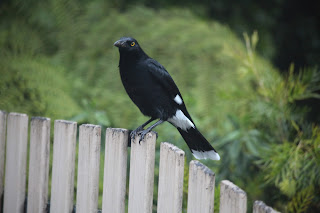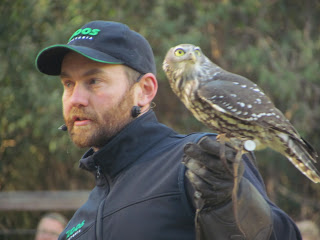Our First Try- FAIL- All that was seen were logrunners and the other usual birds
Our Second Try- HIT!- Not only did we get a glimpse of the lyrebird (but not a pic), we also spotted a rose robin and more logrunners on this try!
Our Third Try- HIT! We finally spotted that pesky owlet-nightjar! Plus, we heard the green catbird!
In other words, we managed to see one of the star birds of O'Reilly's, plus two bonus lifers!
A painting of the display of the beautiful Albert's lyrebird
Can you see the owlet-nightjar?
After our successes, we drove back to the Gold Coast. The road was long and winding, but since it wasn't raining we managed to survive, birding along the way. As we were driving in the eucalypts, something big and black flew into a nearby tree. It could only be one thing- Glossy black cockatoos!
The glossy black cockatoo. This is a male, females have yellowish spots on their heads.
After that, we kept our eyes peeled, and soon spotted pretty-faced wallabies!After we got through the winding roads, the landscape was mostly farmland. Black-faced cuckoo-shrikes were everywhere. Just then, we startled a beautiful parrot. PALE-FACED ROSELLA!
This is a bad photo of a beautiful bird- the pale-faced rosella!
Soon we got to our hotel in Surfer's Paradise, and ate at the Revolving Restaurant. My mother got sick on oysters. I think she got shellfish poisoning. She's still crying about it here at home!
DAY 4
We woke up at 5:55. Like a military commander, I got the others to wake up. We had whale-watching! What really got me excited was the chance to see seabirds, and the 100% whale sightings guarantee! We were not dissapointed- when we got past the rough water, 5 whales started swimming around the boat! One even breached! They were all southern humpback whales, with a few common bottlenose dolphins swimming near them. Flying in the ocean were Australasian gannets, as well as a lifer, a WEDGE-TAILED SHEARWATER!
I'm pretty sure this is a wedge-tailed shearwater. If I'm wrong, please correct me.
As we got back in to the Gold Coast area, we could see heaps of great crested terns, little pied cormorants, silver gulls and white-faced herons on the sandy spit. A fitting end to this great trip.
Crested terns and silver gulls.



































